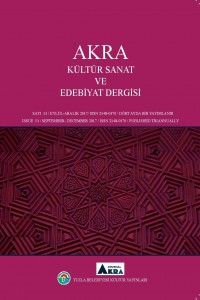Abstract
Bu
makale yeni dini hareketlerin (YDH) temel argümanlarının aslında klasik dinlerin ‘eski’ terim ve
kurumlarını “yenilemek” yani ayrışıp farklılaşmak gibi diyalektik bir dile
dayanıp dayanmadığını tartışmaktadır. Çağdaş din bilimlerine göre YDH’lere ait
temel fenomenler aslında sekülerleşmenin yarattığı imkanların bir sonucudur.
Bir başka ifadeyle bu akımlar, kendi çağlar[1]ı olan post-modern günlerde
artık klasik çağların gelenekleri gördükleri dinlerin yerini almak isterler.
Keywords
References
- Rose, Stuart (2006), “Spirtiuality, Encyclopedia of New Religious Movements, ed. Peter B. Clarke, New York- London, ss. 600- 602. Sarıkçıoğlu, Ekrem (2000), “Yeni Dinî Akımlar”, Dinler Tarihi Araştırmaları II Sempozyum:20–21 Kasım 1998 Konya, Ankara, ss. 81–87. Sethi, A. S. (1990–1991), ‘Self transformation’, Journal of Comparative Sociology and Religion, ss. 1–56. Stark, Rodney (1987), “How New Religions Succeed: A Theoretical Model”, The Future of New Religious Movements, ed. David G. Bromley-Phillip H. Hammond, ss. 11- 29. Swator, William H. (1998), “Church- Sect Theory”, Encyclopedia of Religion and Society, ed. Peter Kivisto, Altamira, ss. 90-94.
THE DISTINCTION OF THE NEW AGE RELIGIOUS MOVEMENTS FROM THE TRADITIONAL RELIGIONS: POSTMODERN PAGANISM VERSUS TRADITIONAL RELIGIOSITY
Abstract
This article discusses the fact that whether the basic arguments of new age movements (NAM) -such as all the terms of the classical religions are Òthe oldÓ therefore along with all its institutions need to be renewed base on the dialectical discourses. According to the contemporary religious studies, NAM-s are the result of the secularisation process of the religious phenomena. In other words, such these fractions demands to fix themselves up in the places of the Òold religionsÓ, claiming that nowadays are theirs own.
Keywords
References
- Rose, Stuart (2006), “Spirtiuality, Encyclopedia of New Religious Movements, ed. Peter B. Clarke, New York- London, ss. 600- 602. Sarıkçıoğlu, Ekrem (2000), “Yeni Dinî Akımlar”, Dinler Tarihi Araştırmaları II Sempozyum:20–21 Kasım 1998 Konya, Ankara, ss. 81–87. Sethi, A. S. (1990–1991), ‘Self transformation’, Journal of Comparative Sociology and Religion, ss. 1–56. Stark, Rodney (1987), “How New Religions Succeed: A Theoretical Model”, The Future of New Religious Movements, ed. David G. Bromley-Phillip H. Hammond, ss. 11- 29. Swator, William H. (1998), “Church- Sect Theory”, Encyclopedia of Religion and Society, ed. Peter Kivisto, Altamira, ss. 90-94.
Details
| Journal Section | Research Articles |
|---|---|
| Authors | |
| Publication Date | September 30, 2017 |
| Acceptance Date | September 22, 2017 |
| Published in Issue | Year 2017 Volume: 5 Issue: 13 |


